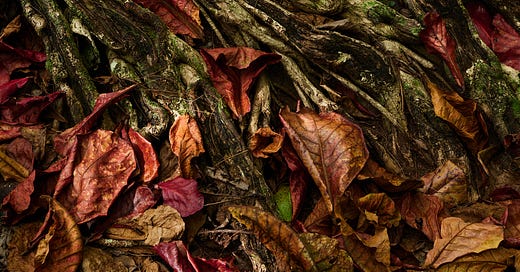Photography is as much a subjective pursuit as it is a creative one. We make choices every time we take camera in hand, decide on a subject, post-process the image and, finally, print it.
I know lots of photographers who only print on two or three papers they know best. That's not a bad practice. Even in our studio, Bob and I have our stand-by papers, but we also test (and use) many others in the course of a year. In fact, Bob just posted an insightful article comparing two baryta papers that we recently tested (with the results of other tests coming soon).
With Fall in the air, I'd like to describe what happened last week in our studio over a two-day period. We needed to print a fall image that I took a year ago on the Napali coast of Kauai, Hawaii. Kauai doesn't have a typical Fall season, but in some areas of the island there can be a greater leaf fall at some points than at others. The image above is the one I captured on a photo hike one day.
The issue I faced was what paper did I feel would best represent the mood I sought? As it turns out, earlier this year I was named the first International Ambassador for the Awagami Paper Factory in Japan. While we absolutely love the papers they craft, Bob and I are still learning about which images are best suited for a specific washi paper. We have written about this on SubStack before.
Testing Papers
So, here we were last week trying out that image on various papers. We started with a paper that we love and that we often use as a baseline before trying other papers. We made three 8.5 x 11" proof prints on Moab's Entrada Natural (full disclosure: Moab is one of our sponsors). Entrada is a cotton paper with a high DMax. We use it so often we feel comfortable judging how other papers might perform having seen an image printed on Entrada first.
We always proof on letter-size paper before rendering a large print, or any print on pricey paper. And, Awagami papers are a bit pricey due to their hand-made quality.
The print on Entrada came out as we expected; perfect. We did some very minor post-processing on it, mostly using local adjustments to increase contrast in order to add some depth to the image. On its own merits, the result was excellent. When we eventually print it on Entrada in large format I'm certain we will be quite happy with it.
However, that wasn't the goal of the project. We actually wanted to find out how two other papers from Awagami worked with the same image and with no further modifications. These are two papers that are still on our learning curve as we explore their unique characteristics, and which we cover in our Awagami workshops.
The first is a medium-weight (180 GSM), subtly textured matte paper called Premio Kozo White. Using the provided Awagami ICC profile and one of our Canon ProGraf 1000 printers, we made a 13 x 19" (A3+) print. Straight out of the printer we were amazed. The image and paper were an absolutely perfect match.
Premio Kozo's DMax is considerably lower than Entrada's. However, the resulting print was more naturalistic; more painterly, imparting a moody quality that we really liked. The painterly quality avoided even a hint of a "digital look", which is a welcome sight (at least to my eyes).
Finally, we tried the same file on Awagami's Murakumo Kozo Select White. This incredible paper is, excuse the pun, paper thin, at 42 GSM. Personally, I did not like this particular image on the Murakumo, while Bob did. The DMax was seriously reduced, even compared to the Premio Kozo.
To be fair, we did not alter the post-processing at all, so we are definitely climbing that learning curve in terms of what each particular Awagami paper needs and what type of image works best for a specific paper. We plan to keep you informed as we continue our experiments. But I do want to point out that this same lesson applies to any photographer who prints. It takes practice and experience to master paper choice and processing.
For those of you who have not seen our past newsletters, we already covered our use of the most gorgeous paper we have ever used, Awagami's Bizan. Bizan is a heavily textured paper with excellent DMax. Sold in sheets with striking deckled edges, the resulting print is literally breathtaking. I have had visitors to our studio gasp when they see a print on this paper. It is expensive, though, but worth every penny. To stretch our investment in this extraordinary paper, we always print a proof on Moab Entrada first to gauge what it might look like on Bizan.
I plan to post a newsletter on how I create the display for the Kozo paper print of the fall leaves. Stay tuned for that. And, please consider becoming a paid subscriber to support our experiments with papers, printers and displays that we bring to you, as well as the paid-subscriber-only benefits. Thank you!




